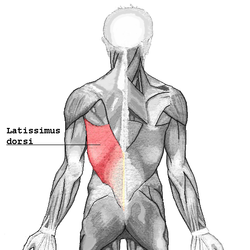Back training has had its share of controversy over the years; whether it’s a debate on the correct form of exercises, the sets and reps, or the time needed to spend on them. Let me start by going over the basics…
Your lats are actually made up of three muscles called the Dorsi, Teres Major and Teres Minor which are attached to the scapula. This muscle primarily plays the role of a “puller” or agonist in major exercise movements such as the pull- up or seated row. It also acts as the antagonist (opposing force) in all chest press exercises.
Given that the lats only consist of one head, they can be difficult to isolate at times because the secondary muscles (Biceps/Deltoids) are also engaged in contraction. However it is STILL possible to isolate your lats! You just have to be creative with your exercise selection. I’ll go over this more in a minute…
Recently in my Chest article (Dominant muscles of the human body), I explained how maximum stimulation must be achieved in order to get the best results. So much like the chest, your back must be taken to complete failure over and over again to cause as much micro trauma to the muscle fibers as possible.
Every single back pulling exercise consists of muscular tension and contraction STARTING at the hands. When force is applied and your brain signals to pull the weight towards you, the path of contraction travels from your hands up your arms and into your back. The flow of contraction looks something like this:

So how do I use my lats as the Prime Mover instead of my forearms and biceps? The answer lies in your grip! Using a standard fist-like grip on the bar is the first mistake most people make when jumping on a lat pulldown machine. I see it every single day in the gym and it’s a wonder why I have new clients who say, “I can only feel it in my arms.” So let’s correct this shall we?
The simplest way to shift more tension into your lats instead of your biceps is to treat your hands as hooks. From a standard fist-like grip, the only change would be to lift your thumbs and place them on top of the bar with your other fingers! Simple as that. So on your next back day, try a standard grip first, then switch your thumbs and feel the difference!
For any effective back workout, these simple concepts must be put into action. Building up a pump is also important to ensure as much blood circulation through the muscle as possible. As mentioned before, the back CAN be isolated, and I’ll explain how…
Think of the standard cable row machine you currently use at your gym. Most likely it’ll have an attachment hook with all kinds of grip handles. This exercise will be performed with only one arm at a time so find a single pulley to attach to the machine. Instead of being seated facing the stack of weight, grab the pulley (still using your hands as hooks) and shift your body sideways about 45 degrees. Your arm should now be in a straight line with your hip. Pull the weight towards you in a controlled motion. Your elbow should drop down close to your hip. Try it right now without any weight, and squeeze your lats. Do you feel it? That right there my friend is an isolation movement for your back. I suggest trying this at the end of your next lat workout and let me know how it feels!
Remember, your mind is a powerful thing. Prepare it for the work you’re about to do day-in and day-out. Establishing a Mind-Muscle connection with your back is key to a progressive and successful workout. Train hard, and keep your Mindset!
Summary with credit to: Permanent Muscle by Reuben Bajada. The Poliquin Principles by Charles Poliquin. ACEFitness.org